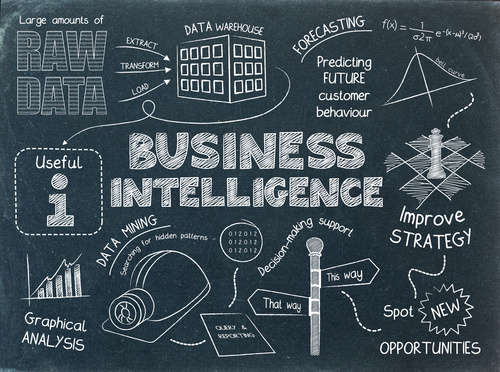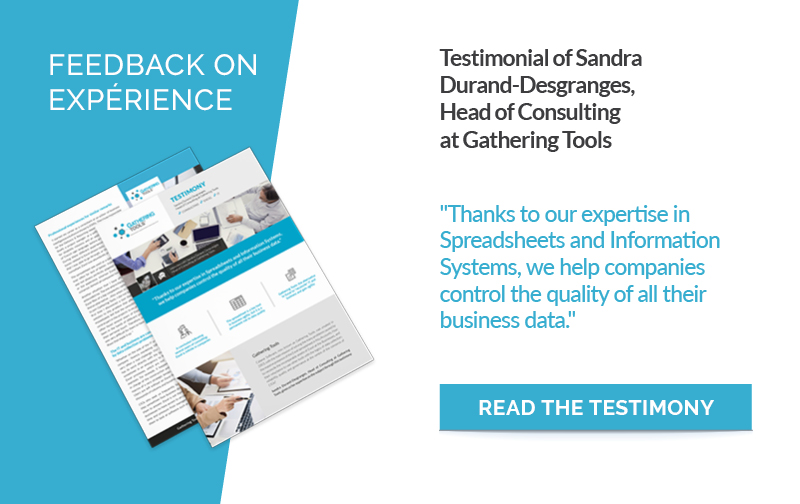Business Intelligence has been on all key strategic committees for key accounts for a few years now. Data sets of Big Data is aggregated again and again to create all kinds of indicators. However, it is difficult for CIOs to keep the main focus on what is happening in the different departments of the company. Everyone wants to be able to manipulate the data as it sees fit, no matter where they come from. BI dashboards flourish here and there, without the accuracy of the data being verified, and it is possible to trace the career path. In this context, how to give more depth to BI projects while facing the data management policy of the company?
The challenges when collecting data from BI projects
 Business Intelligence is evolving at a high speed. We are moving from “modern BI”, focused on business and user needs, to “Smart Data Discovery”*, a more intuitive and graphic BI. While we can welcome these advances, the fact remains that the issue of data collection is still unresolved. Indeed, many BI players, whether in the enterprise or at the integrators or publishers, remain focused on the Data Visualisation part and tend to forget how these wonderful dashboards are built.
Business Intelligence is evolving at a high speed. We are moving from “modern BI”, focused on business and user needs, to “Smart Data Discovery”*, a more intuitive and graphic BI. While we can welcome these advances, the fact remains that the issue of data collection is still unresolved. Indeed, many BI players, whether in the enterprise or at the integrators or publishers, remain focused on the Data Visualisation part and tend to forget how these wonderful dashboards are built.
Benefiting from strategic indicators, is an excellent thing but they must be reliable. There are many BI projects that may be considered incomplete. They are powered by a percentage of data, considered reliable, extremely low compared to what actually passes through the company, all Excel workbooks for example! And if a dashboard carries only 70% of the existing data, making strategic choices is highly risky.
Make Business Intelligence Smarter
 To deal with these complex situations, it is essential to find solutions. One of them is to set up a reference data management, or Master Data Management, within the company. This is a great way to ensure that all departments work on the same basis and follow certain rules. Unfortunately, only 18% of CIOs have reference data management for key data such as, customer identity, employee identity, products, etc. Much effort remains to be done. Moreover, this is not enough because it is not a guarantee that this data will then be correctly collected to feed the BI.
To deal with these complex situations, it is essential to find solutions. One of them is to set up a reference data management, or Master Data Management, within the company. This is a great way to ensure that all departments work on the same basis and follow certain rules. Unfortunately, only 18% of CIOs have reference data management for key data such as, customer identity, employee identity, products, etc. Much effort remains to be done. Moreover, this is not enough because it is not a guarantee that this data will then be correctly collected to feed the BI.
Another solution consists in imposing software tools on the business sector, which constrain them in their practices and prevent the data from leaving the perimeter of the IT department. But let’s be honest, this method does not work. This will only strengthen shadow IT, already well present in big companies.
It is therefore better to give businesses the opportunity to maintain their working methods while integrating their processes into the IS, and to give them the means to make them more reliable. This is the best way to collect quality raw data, as close as possible to the field, which can efficiently feed Business Intelligence solutions. But how to do it ?
A collection solution that reconciles IT departments and business sector
 Numerous businesses still use Excel to collect and process field data before integrating them into ERP, EPM, BI and other software, when possible! As proof, 12% of employees in European companies are considered as advanced users of Excel, i.e. 5.5 million people. They spend nearly 28 hours a week! For more figures on the subject, discover our infographic “spreadsheets in companies”. Yet, the limits of spreadsheet software are no longer to prove!
Numerous businesses still use Excel to collect and process field data before integrating them into ERP, EPM, BI and other software, when possible! As proof, 12% of employees in European companies are considered as advanced users of Excel, i.e. 5.5 million people. They spend nearly 28 hours a week! For more figures on the subject, discover our infographic “spreadsheets in companies”. Yet, the limits of spreadsheet software are no longer to prove!
To overcome this, fortunately, there is a simple solution to implement called Gathering Tools! It keeps the existing Excel by providing features that were previously lacking, such as, enhanced validation processes, advanced version tracking, etc. Above all, it makes it possible to integrate all these independent files into the IS, thus to ensuring their integration into the BI projects of the company.
Thanks to Gathering Tools, you have the perfect way to add extraordinary depth of data to your BI projects and increase their relevance to decision-makers!
* Gartner “Magic Quadrant for Business Intelligence and Analytics Platforms”




